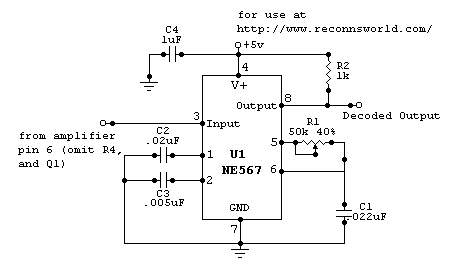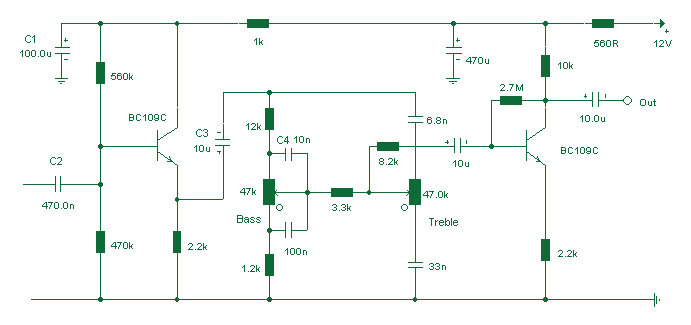
sound detector tone decoder

This circuit is designed to trigger on a 1 kHz tone. To change this frequency, refer to the table below, then change the resistor and capacitor values accordingly. More: all resistors are 5 or 10 percent tolerance, 1/4-watt; all capacitors are 10 percent tolerance, rated 35 volts or higher.
The described circuit functions as a frequency-sensitive triggering mechanism, specifically designed to activate in response to a 1 kHz audio tone. The fundamental operation likely involves a combination of resistors and capacitors configured in an RC timing circuit, which determines the frequency of oscillation.
To modify the frequency of the circuit, it is essential to adjust the values of the resistors and capacitors according to a predefined table, which presumably outlines the necessary component values for various target frequencies. The choice of resistors with a tolerance of 5% or 10% and a power rating of 1/4 watt ensures that the circuit maintains a reliable performance under typical operating conditions. Similarly, the capacitors are specified with a tolerance of 10% and a voltage rating of at least 35 volts, which provides adequate headroom for voltage fluctuations and ensures the longevity of the components.
The circuit may include additional features such as a comparator or a microcontroller to process the incoming tone and provide a digital output or trigger an external device. This could be beneficial in applications where precise tone detection is required, such as in alarm systems, audio processing, or communication devices.
For practical implementation, it is advisable to use a breadboard for initial testing, allowing for easy adjustments of component values to achieve the desired frequency response. Once the circuit is finalized, a PCB design can be created to ensure a compact and robust deployment in a final product. Proper layout considerations should be taken to minimize noise and interference, particularly in environments with other electronic devices.This circuit is designed to trigger on a 1 khz tone. to change this frequency - refer to the table below, then change the resistor and capacitor values accordingly. all resistors are 5 or 10 percent tolerance, 1/4-watt all capacitors are 10 percent tolerance, rated 35 volts or higher 🔗 External reference
The described circuit functions as a frequency-sensitive triggering mechanism, specifically designed to activate in response to a 1 kHz audio tone. The fundamental operation likely involves a combination of resistors and capacitors configured in an RC timing circuit, which determines the frequency of oscillation.
To modify the frequency of the circuit, it is essential to adjust the values of the resistors and capacitors according to a predefined table, which presumably outlines the necessary component values for various target frequencies. The choice of resistors with a tolerance of 5% or 10% and a power rating of 1/4 watt ensures that the circuit maintains a reliable performance under typical operating conditions. Similarly, the capacitors are specified with a tolerance of 10% and a voltage rating of at least 35 volts, which provides adequate headroom for voltage fluctuations and ensures the longevity of the components.
The circuit may include additional features such as a comparator or a microcontroller to process the incoming tone and provide a digital output or trigger an external device. This could be beneficial in applications where precise tone detection is required, such as in alarm systems, audio processing, or communication devices.
For practical implementation, it is advisable to use a breadboard for initial testing, allowing for easy adjustments of component values to achieve the desired frequency response. Once the circuit is finalized, a PCB design can be created to ensure a compact and robust deployment in a final product. Proper layout considerations should be taken to minimize noise and interference, particularly in environments with other electronic devices.This circuit is designed to trigger on a 1 khz tone. to change this frequency - refer to the table below, then change the resistor and capacitor values accordingly. all resistors are 5 or 10 percent tolerance, 1/4-watt all capacitors are 10 percent tolerance, rated 35 volts or higher 🔗 External reference





